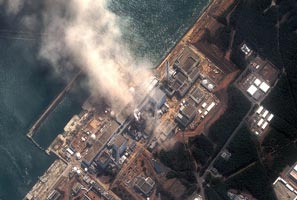
Update March 18: New interview on Japanese radiation risk with atmospheric physics researcher.
Earlier post
It's human nature to view catastrophes like those hitting Japan through a self-protective lens. Thus, when I woke up this morning, my first concern, irrational or not, was about any potential danger from trans-continental radiation traveling our way.
Apparently, I'm not the only one. From the Santa Rosa Press Democrat:
Suppliers see big demand in U.S. for anti-radiation pills
Fear of nuclear fallout from Japan's earthquake- and tsunami-battered nuclear power plants has created a nationwide scramble for potassium iodide, a compound that can protect thyroid glands from radioactivity. "We sold out," said Maxine Ward, who works in the supplement department of the Ukiah Natural Foods Co-Op...
Ward has ordered more potassium iodide, but national retail suppliers have been swamped with requests. "They're all out of stock," said Leila-Anne Brusseau, at Santa Rosa Community Market. The store normally does not stock the product but has been trying to get some because of demand. "I'm getting a call every five minutes," Brusseau said. She said her main supplier told her they'd sold out after filling 1,200 orders in the first half hour of business on Monday.
The quest for anti-radiation pills appears to be an overreaction, at least according to the government, scientists, and health experts. From the U.S. Nuclear Regulatory Commission on March 13: "NRC Sees No Radiation at harmful levels Reaching U.S. From Damaged Japanese Nuclear Power Plants."